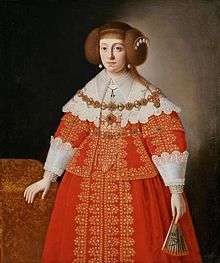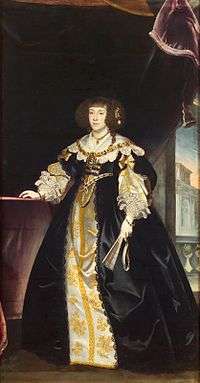Cecilia Renata of Austria
| Cecilia Renata of Austria | |
|---|---|
 | |
| Queen of Poland | |
| Tenure | 12 September 1637 – 24 March 1644 |
| Coronation | 12 September 1637 |
| Born |
16 July 1611 Graz, Austria |
| Died |
24 March 1644 (aged 32) Vilnius, Polish-Lithuanian Commonwealth |
| Spouse | Władysław IV Vasa |
| Issue |
Sigismund Casimir Maria Anna Isabella |
| House | House of Habsburg |
| Father | Ferdinand II, Holy Roman Emperor |
| Mother | Maria Anna of Bavaria |
Archduchess Cecilia Renata of Austria (German: Cäcilia Renata; Polish: Cecylia Renata; 16 July 1611 – 24 March 1644) was Queen of Poland as consort to the Polish-Lithuanian Commonwealth's King Władysław IV Vasa.
Biography
Cecilia Renata was a daughter of Ferdinand II, Holy Roman Emperor, of the House of Habsburg, and Maria Anna of Bavaria. Born in 1611 in Graz, she was chosen as bride by the Polish nobility. She married Władysław on 9 August in Vienna by proxy, and then in Warsaw in person on 12 September 1637, and the same day was crowned at St. John's Cathedral.[1] This was the first royal coronation outside of Kraków, the historic, former capital of Poland, and this greatly angered the Polish nobility. A law was instigated to reserve coronations to Kraków in 1638.

Young and energetic, she soon began organising the royal court to her liking. She was popular, especially for her politeness. One noble wrote in his memoirs that she insisted other women sit with her, even though she was queen. Cecilia could not remove her husband's mistress, Hedwig Łuszkowska, by herself, so she arranged a marriage between Hedwig and Starosta Merecki, John Wypyski. In 1638, Cecilia and Władysław visited Vienna.
Cecilia advocated the Habsburg and pro-Catholic point of view and allied herself with the pro-Habsburg faction of chancellor Jerzy Ossoliński and pro-Catholic Albrycht Stanisław Radziwiłł. Her political opponent at the court was the faction of Adam Kazanowski, whose influence over King Władysław, his childhood friend, diminished after her marriage. Kazanowski was allied with Chancellor Piotr Gembicki, who thus became one of her opponents. Her influence was strong for the first 2–3 years of marriage, and she had much to say about the royal nominations for important official positions. After 1638/1639 when Władysław realised that Habsburgs were prepared to give him little assistance, her power waned, and he started to disregard her advice.
Cecilia kept in contact with her brothers and continued an intimate attachment with them; she also became friends with her sister-in-law Anna Catherine. She enjoyed music, concerts, theatre performances and this may have greatly influenced her husband, who was one of the founders of Polish national theatre and brought many famous and well-known artists and performers from all around Europe to the country.
During her marriage she became pregnant three times: Her first child, a son Sigismund Casimir was born on 1 April 1640 and died aged seven, on 9 August 1647; her second child, a daughter Maria Anna Isabella was born on 8 January 1642 and died one month later, on 7 February 1642. On 23 March 1644 Cecilia Renata gave birth her third child, a stillborn daughter.[2] She died next day as a consequence of an infection, likely related to her recent childbirth. Following her sudden death, Cecilia Renata was deeply mourned by both Władysław and the Royal Polish court. She also left a good impression on the public, mostly for her piety and good will.
Ancestors
| Ancestors of Cecilia Renata of Austria | ||||||||||||||||||||||||||||||||||||||||||||||||||||||||||||||||||||||||||||||||||||||||||||||||||||||||||||||||||||||||||||||||||||||||||||||||||||||||||||||||||||||||||||||||||||||||||||||||||||||||||||||||||||||||||||||||||||||||||||||||||||||||||||||||||||||||||||||||||||||||||||||||||||||||||||||||||||||||||||||||||||||||||||||||||||||||||||||||||||||||||||||||||||||||||||||||||||||||||||||||||||||||||||||||||||||||||||||||||||||||||||||||||||||||||||||||||||||||||||||||||||||||||||||||||||||||||||||||||
|---|---|---|---|---|---|---|---|---|---|---|---|---|---|---|---|---|---|---|---|---|---|---|---|---|---|---|---|---|---|---|---|---|---|---|---|---|---|---|---|---|---|---|---|---|---|---|---|---|---|---|---|---|---|---|---|---|---|---|---|---|---|---|---|---|---|---|---|---|---|---|---|---|---|---|---|---|---|---|---|---|---|---|---|---|---|---|---|---|---|---|---|---|---|---|---|---|---|---|---|---|---|---|---|---|---|---|---|---|---|---|---|---|---|---|---|---|---|---|---|---|---|---|---|---|---|---|---|---|---|---|---|---|---|---|---|---|---|---|---|---|---|---|---|---|---|---|---|---|---|---|---|---|---|---|---|---|---|---|---|---|---|---|---|---|---|---|---|---|---|---|---|---|---|---|---|---|---|---|---|---|---|---|---|---|---|---|---|---|---|---|---|---|---|---|---|---|---|---|---|---|---|---|---|---|---|---|---|---|---|---|---|---|---|---|---|---|---|---|---|---|---|---|---|---|---|---|---|---|---|---|---|---|---|---|---|---|---|---|---|---|---|---|---|---|---|---|---|---|---|---|---|---|---|---|---|---|---|---|---|---|---|---|---|---|---|---|---|---|---|---|---|---|---|---|---|---|---|---|---|---|---|---|---|---|---|---|---|---|---|---|---|---|---|---|---|---|---|---|---|---|---|---|---|---|---|---|---|---|---|---|---|---|---|---|---|---|---|---|---|---|---|---|---|---|---|---|---|---|---|---|---|---|---|---|---|---|---|---|---|---|---|---|---|---|---|---|---|---|---|---|---|---|---|---|---|---|---|---|---|---|---|---|---|---|---|---|---|---|---|---|---|---|---|---|---|---|---|---|---|---|---|---|---|---|---|---|---|---|---|---|---|---|---|---|---|---|---|---|---|---|---|---|---|---|---|---|---|---|---|---|---|---|---|---|---|---|---|---|---|---|---|---|---|---|---|---|---|---|---|---|---|---|---|---|---|---|---|---|---|---|---|---|---|---|---|---|---|---|---|---|---|---|---|---|---|---|---|---|---|---|---|---|---|---|---|---|---|---|---|---|---|---|---|---|---|---|---|---|---|---|---|---|---|---|---|---|---|---|---|---|---|---|---|---|---|---|---|---|---|---|---|---|---|---|---|---|---|---|---|---|---|---|---|---|
| ||||||||||||||||||||||||||||||||||||||||||||||||||||||||||||||||||||||||||||||||||||||||||||||||||||||||||||||||||||||||||||||||||||||||||||||||||||||||||||||||||||||||||||||||||||||||||||||||||||||||||||||||||||||||||||||||||||||||||||||||||||||||||||||||||||||||||||||||||||||||||||||||||||||||||||||||||||||||||||||||||||||||||||||||||||||||||||||||||||||||||||||||||||||||||||||||||||||||||||||||||||||||||||||||||||||||||||||||||||||||||||||||||||||||||||||||||||||||||||||||||||||||||||||||||||||||||||||||||
Notes
- ↑ Podhorodecki, Leszek (1985). Wazowie w Polsce. Warszawa: Ludowa Spółdzielnia Wydawnicza. pp. 264–265. ISBN 83-205-3639-1.
- ↑ S. Ochmann-Staniszewska, Dynastia Wazów w Polsce, Warsaw 2006, p. 141.
See also
| Wikimedia Commons has media related to Cecilia Renata of Austria. |
External links
- Discussion of the portrait, in Polish It is unknown whether this picture presents Cecylia Renata or Gryzelda Konstancja z Zamoyskich Wiśniowiecka, as the historical sources are indecisive.
- The Significance of the Crown Portrait of King Sigismund II Augustus by Peter Danckerts de Rij
| Cecilia Renata of Austria Born: 16 July 1611 Died: 24 March 1644 | ||
| Royal titles | ||
|---|---|---|
| Preceded by Constance of Austria |
Queen consort of Poland Grand Duchess consort of Lithuania 1637–1644 |
Succeeded by Marie Louise Gonzaga |